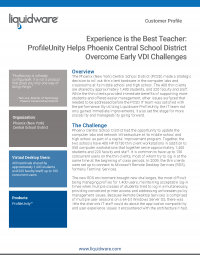Phoenix Central School District Uses ProfileUnity to Overcome Early VDI Challenges
New York’s Phoenix Central School District (PCSD) made a strategic decision to roll out thin client hardware in the computer labs and classrooms at its middle school and high school. Its 400 HP t5730 thin client workstations 550 computer workstations are shared by approximately 1,400 students, and 220 faculty and staff. It’s common to have up to 130 concurrent users on the thin clients, most of whom try to log in at the beginning of class periods. When first set up in 2009, the thin clients were connected to Microsoft Remote Desktop Services (RDS - formerly Terminal Services). The RDS environment brought challenges, the most difficult of which were:
- managing 1,400 user profiles
- maintaining acceptable log-in times when multiple classes of students logged in simultaneously
- providing convenient printer access
- addressing unforeseen policy management issues
Because Remote Desktop Services is composed of multiple user sessions on a 64-bit Windows Server OS, there was little the district’s IT staff could do about application compatibility and user-experience issues that emerged. The district’s director of technology attributed the slow log-in times to ‘I/O storms’ that broke out when 90 students tried to log in at the same time. Printer-access complications were caused by the fact selecting the Print command produced a list of every printer in the school, requiring students to identify the closest printer to the lab or classroom in which they were working. The district’s director of technology had expected to use Microsoft tools to manage the virtual desktops the same way he managed the physical PCs. However, he was dismayed to discover that the Microsoft tools prevented specifying virtual desktop access to nearby printers, the Group Policy tools were too blunt of an instrument for the district’s needs, and Microsoft’s Roaming Profiles management capabilities were a source of long login times as well as being subject to profile corruption.
PCSD’s IT staff turned to solutions provider and Liquidware partner TERACAI to help create a responsive and flexible environment. Together they identified hardware and software solutions, with PCSD IT staff ultimately selecting VMware View as its VDI platform after many proof-of-concept trials. The IT staff created a single golden desktop image using VMware’s non-persistent linked-clone technology to provide a consistent user experience while minimizing resources needed to power the virtual desktops in the data center. The district also decided to upgrade its management abilities by installing the ProfileUnity user virtualization solution from Liquidware and investing in SSD-based storage area network (SAN) arrays for the linked-clone replica images. ProfileUnity manages profiles for both the traditional, nonvirtualized Windows PCs and the virtual desktops.
The director of technology estimates that the amount of time that the IT staff needs to spend on desktop support has been cut in half, enabling the team to be much more proactive and to work on building solutions instead of fixing problems. He characterizes ProfileUnity as "an essential part of the district’s ecosystem."

